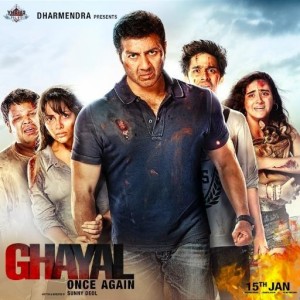Be it large portions or minute detailing, visual effects are widely being used to enhance the process of film making in the current scenario. The recent blockbuster Ghayal Once Again witnessed a similar use of visual effects to create few portions of the film which could not be achieved with the normal camera shots.
 The Mumbai based studio After, created the shots for Ghayal in terms of visual effects thus producing a clean final output. The studio delivered around 650 VFX shots in a span of just two months.
The Mumbai based studio After, created the shots for Ghayal in terms of visual effects thus producing a clean final output. The studio delivered around 650 VFX shots in a span of just two months.
VFX Supervisor, Vishwas Savanur recollects, “We had a tight deadline and with a strength of 40 artists we delivered the shots by working for hours together at a stretch within few days.”
Ghayal Once Gain, starring the muscle man Sunny Deol, who also serves as the director of the film, follows the story of the muscular hero fighting as a one-man-army against the corrupt system. Along with Sunny Deol, the film also stars Soha Ali Khan, Om Puri and Manoj Joshi. It is a sequel of the 1990 film Ghayal which also witnessed the same lead hero. This 2016 film, produced by Dharmendra with Dan Bradley as the stunt choreographer, was released on 5 February and earned Rs 23.25 crore during its first weekend.
As the film begins, the film displays the city of lights Mumbai from a top angle aerial view. The tall towers, the stretch of the sea and the streets of Mumbai twinkling with lights in the darkness of the night was created by the team of After. Vishwas says, “We had scenes of Mumbai that were shot during the day. But the shots were hazy, had a lot of fog and nothing was clear at all so we had to convert everything to a night environment.”
The team of After Studio therefore worked on these shots, converted it to the night scene and added lights after cleaning the entire scene so that every building could be seen evidently. Moreover, there are few sequences where Sunny Deol had to be shown weak and weary. Therefore his skin tone, texture of the skin and geometry of his face was changed to suit the character representation. “We wanted to make him look weak as according to the plot he is a prisoner who has spent days without food,” adds Vishwas.
Veteran actor, Sunny Deol, who has done classic films like Arjun, Damini, Ghatak and Border, belongs to the old school category who believes in actual things rather than virtual visual effects. The team of After recollects, “The veteran hero didn’t believe in VFX at the start but later, when he saw our work he widened his horizon and began learning with us.” Vishwas says, “He worked closely with us and learned all the aspects of VFX to see how the final output would look.”
Apart from the aerial view of Mumbai and Sunny’s weak ageing character, there were few sequences of VFX in terms of converting the overview of DY Patil Stadium to the night scene and few clean ups. Nuke software was used for Compositing and Maya for visual effects while, After Effects was used for the add-on effects.
Also, the entire DI (Digital Intermediate) process was led by the team of After studio in terms of colour correction and finalising the tone of the entire film. After has also done the DI on the recently released movie, Airlift which has huge number of visual effects and colour tones blending into each other.
In the current industry with heavy VFX films being produced, toning down the face or creating night scenes is a normal task but After has added its own touch to it in this film. More than that, they have proved to veteran actors like Sunny Deol that the impossible is possible with VFX.

